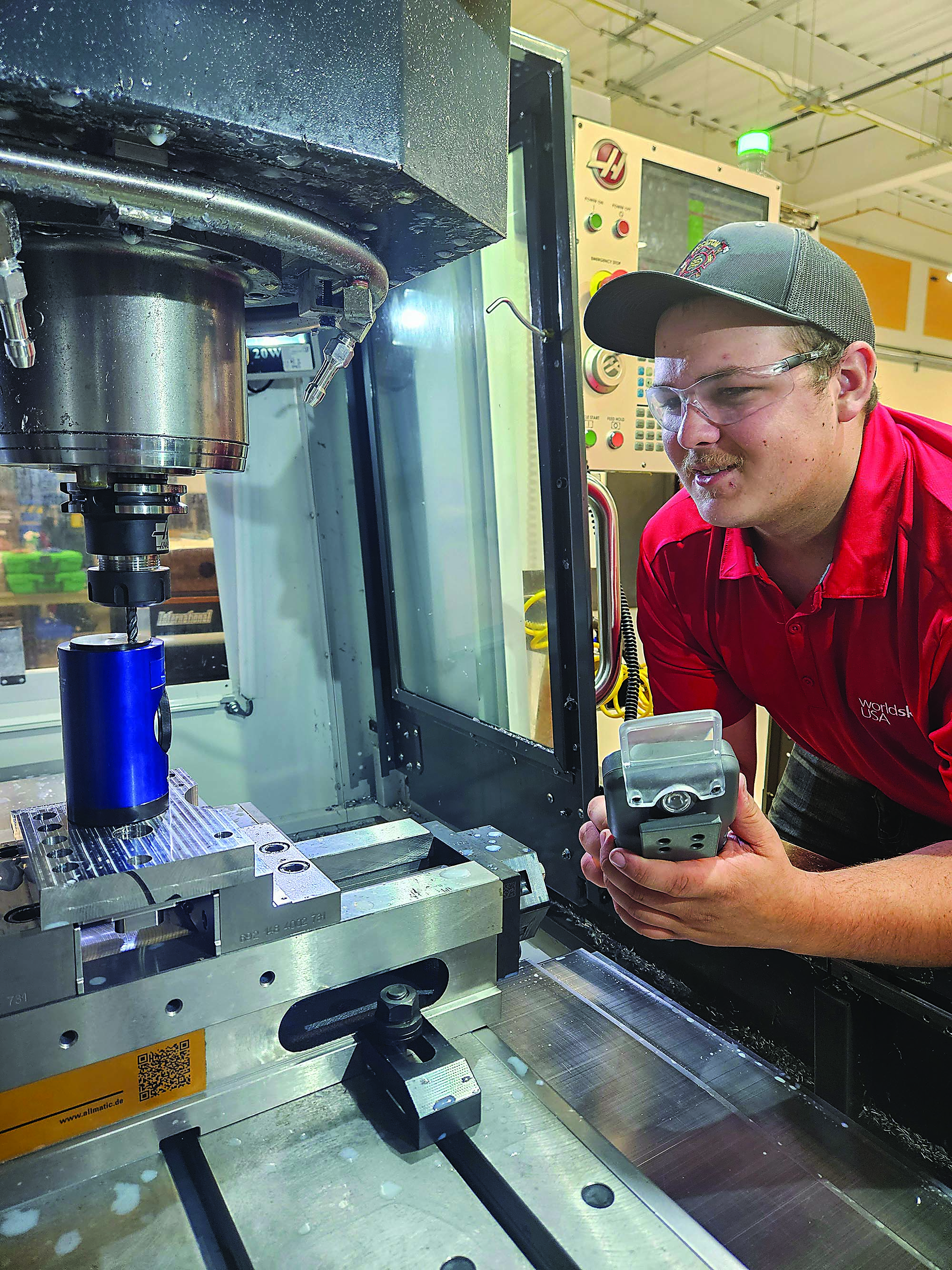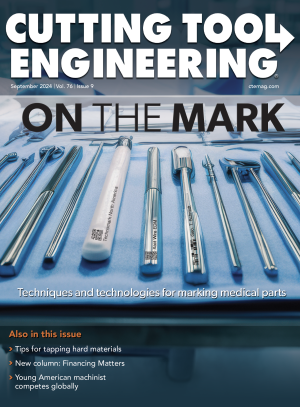This month, a young American travels to France to display machining abilities he owes in part to an organization dedicated to closing the skills gap in the United States.
Kaden Stanczyk, 20, will make the trip from his home in Custer, Wisconsin, to the French city of Lyon to take part in the 47th WorldSkills competition. From Sept. 10 to 15, Eurexpo Lyon will welcome 1,500 contestants from more than 65 countries and regions to take part in 62 trade-skill competitions. Over 250,000 people from around the world are expected to attend the event.
The WorldSkills USA team will compete in several trade areas. American teams for WorldSkills events are assembled and managed by Leesburg, Virginia-based SkillsUSA. Billing itself as “America’s proud champion of the skilled trades,” SkillsUSA is a student-led partnership of educational institutions and industry that aims to assist in the development of graduates who are ready to take their place in the nation’s skilled workforce. Representing nearly 380,000 students and teachers, SkillsUSA chapters can be found in middle schools, high schools and postsecondary institutions across the country. Since 1965, the organization has served more than 14 million members

According to SkillsUSA spokesperson Karen Kitzel, the organization is funded mainly by annual membership dues and donations from industry partners. Industry donations help support national activities such as the SkillsUSA Championships held each June. This year, Kitzel said, the event included 115 contests in different trade areas plus a large trade show and was attended by more than 17,000 people.
The organization’s efforts to produce career-ready graduates include more than just a focus on honing their technical abilities. Called the SkillsUSA Framework, the organization’s training approach covers personal, workplace and technical skills. Developing skills in all three areas is considered crucial for successful careers and lives. Therefore, SkillsUSA also offers instruction and experiences that help students learn and improve in areas such as teamwork, communication and professionalism.
Stanczyk is a member of the SkillsUSA chapter at his school, Mid-State Technical College in Rapids, Wisconsin. Selected by the organization as its WorldSkills competitor for CNC milling, he represented Wisconsin at the SkillsUSA Championships in 2022 and 2023, and also won a national silver medal in precision machining last year.
Stanczyk got an early start in milling, working with his father, Scott. “My dad runs a local machine shop,” he said, adding that he started running CNC equipment in his father’s shop when he was 12. “I got into (machining) there and really enjoyed it.”
In his development as a machinist, Stanczyk’s association with SkillsUSA has been beneficial in a number of ways. For example, he credits the hands-on training provided by the organization as well as the many contests it holds. “Any contest they have will help you with technical skills, and you learn time management because you’re restricted on time,” he said. In addition, he noted that participants learn the importance of their attire and the cleanliness of their work area because they are judged on those things as well.
Skills Trainer
For the WorldSkills milling contest, Stanczyk’s trainer and designated technical expert is JR Colvin from Madison Area Technical College in Madison, Wisconsin. Colvin has been a precision machining and automated manufacturing instructor at the college for the past 22 years. Prior to that, he worked as a toolmaker for 12 years.
For the last 20 years, Colvin has also been a SkillsUSA advisor, working with the organization’s chapter at his school. In this role, much of his work involves preparing student members for competitions with activities such as practice machining. In addition, the group spends time on other areas covered by the SkillsUSA Framework.
“Along with (developing) their technical skill, we also work on creating good workers and good citizens,” Colvin said. Activities in the latter category might include
working at a blood drive or doing roadside cleanups. As for creating good workers, Colvin said the focus is on issues such as the importance of being on time and maintaining a clean and safe work area.
In his role as Stanczyk’s trainer for the WorldSkills milling competition, Colvin’s tasks included lining up CAM training with experts across the country, arranging training on the specific type of machine tool that Stanczyk will be working on, and preparing exercises aimed at making him more comfortable with metric units, which will be used in the contest.
During the CNC milling competition, which will take place over four days, Colvin and Stanczyk will have 15 minutes together each morning to look at the drawing of the part Stanczyk will be making and discuss machining strategies and other issues. After that, Stanczyk is on his own to enter toolpaths into the machine, set up the tooling and workpiece, and machine the part.
When the machining time is finally up, the parts made by Stanczyk and the other contestants will be judged primarily on their dimensional accuracy as determined by a coordinate measuring machine, Colvin explained, with secondary importance given to appearance-related imperfections such as chips or burrs on the parts. Gold, silver and bronze medals will be awarded to the contestants who mill what are judged by these criteria to be the best parts.
When the WorldSkills contest is over, Colvin will return home and continue his pro bono work with machining students. “The industry has been wonderful to me,” he said, “and I love to give back.”
Related Glossary Terms
- computer numerical control ( CNC)
computer numerical control ( CNC)
Microprocessor-based controller dedicated to a machine tool that permits the creation or modification of parts. Programmed numerical control activates the machine’s servos and spindle drives and controls the various machining operations. See DNC, direct numerical control; NC, numerical control.
- computer-aided manufacturing ( CAM)
computer-aided manufacturing ( CAM)
Use of computers to control machining and manufacturing processes.
- gang cutting ( milling)
gang cutting ( milling)
Machining with several cutters mounted on a single arbor, generally for simultaneous cutting.
- milling
milling
Machining operation in which metal or other material is removed by applying power to a rotating cutter. In vertical milling, the cutting tool is mounted vertically on the spindle. In horizontal milling, the cutting tool is mounted horizontally, either directly on the spindle or on an arbor. Horizontal milling is further broken down into conventional milling, where the cutter rotates opposite the direction of feed, or “up” into the workpiece; and climb milling, where the cutter rotates in the direction of feed, or “down” into the workpiece. Milling operations include plane or surface milling, endmilling, facemilling, angle milling, form milling and profiling.
- milling machine ( mill)
milling machine ( mill)
Runs endmills and arbor-mounted milling cutters. Features include a head with a spindle that drives the cutters; a column, knee and table that provide motion in the three Cartesian axes; and a base that supports the components and houses the cutting-fluid pump and reservoir. The work is mounted on the table and fed into the rotating cutter or endmill to accomplish the milling steps; vertical milling machines also feed endmills into the work by means of a spindle-mounted quill. Models range from small manual machines to big bed-type and duplex mills. All take one of three basic forms: vertical, horizontal or convertible horizontal/vertical. Vertical machines may be knee-type (the table is mounted on a knee that can be elevated) or bed-type (the table is securely supported and only moves horizontally). In general, horizontal machines are bigger and more powerful, while vertical machines are lighter but more versatile and easier to set up and operate.
- precision machining ( precision measurement)
precision machining ( precision measurement)
Machining and measuring to exacting standards. Four basic considerations are: dimensions, or geometrical characteristics such as lengths, angles and diameters of which the sizes are numerically specified; limits, or the maximum and minimum sizes permissible for a specified dimension; tolerances, or the total permissible variations in size; and allowances, or the prescribed differences in dimensions between mating parts.








